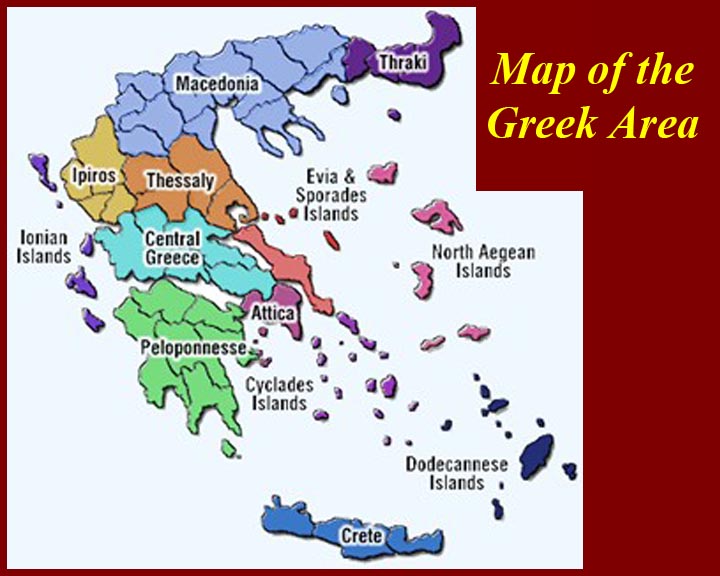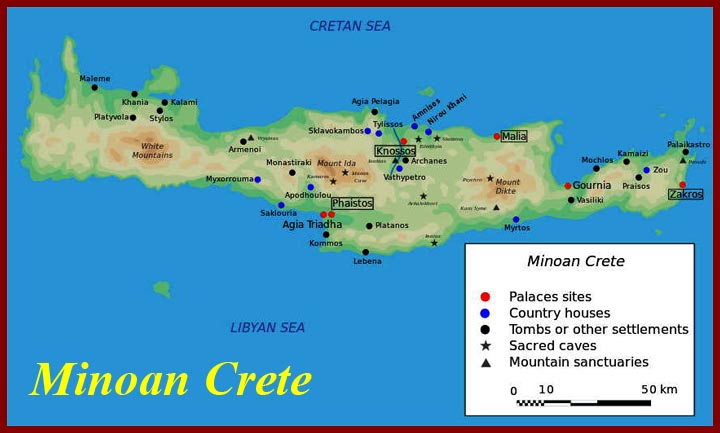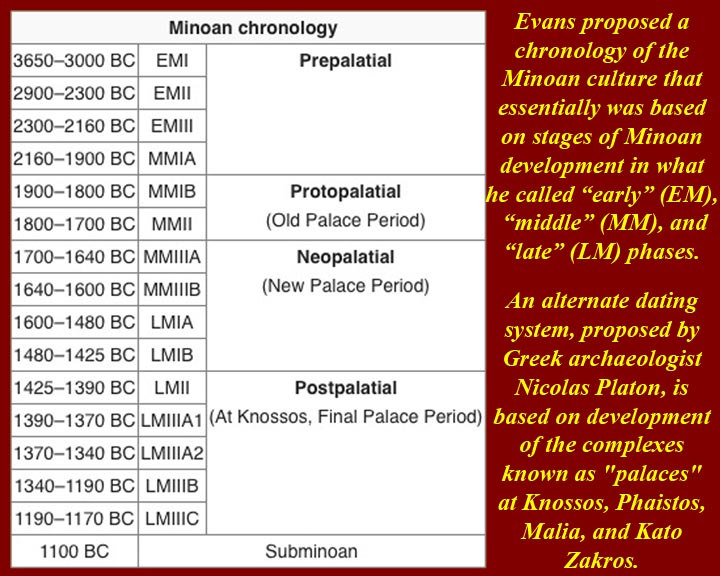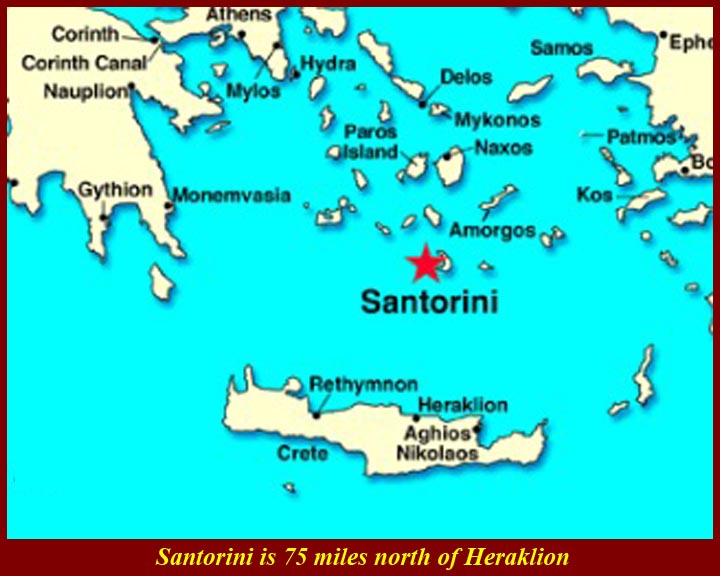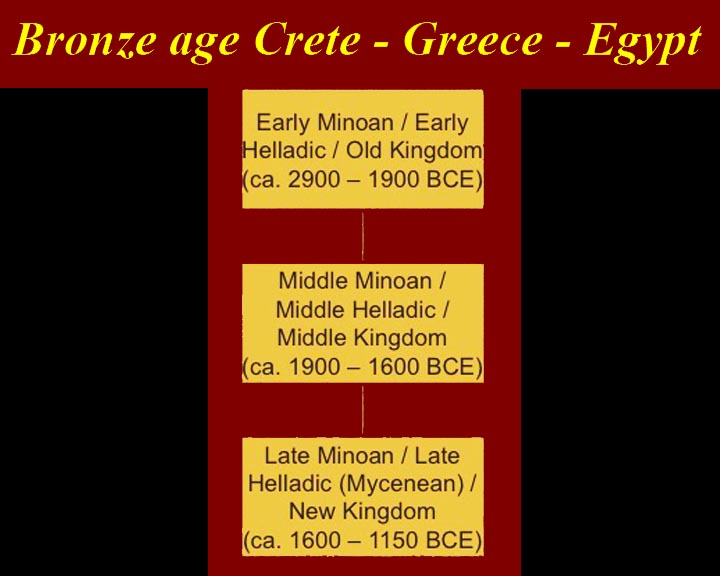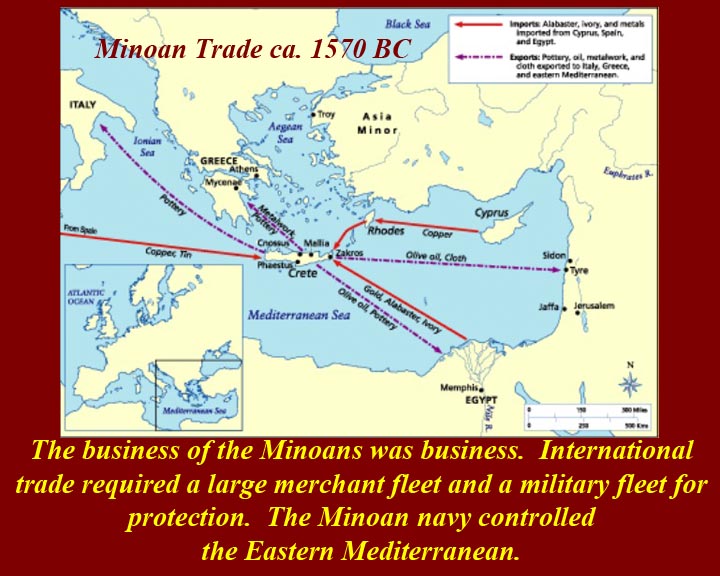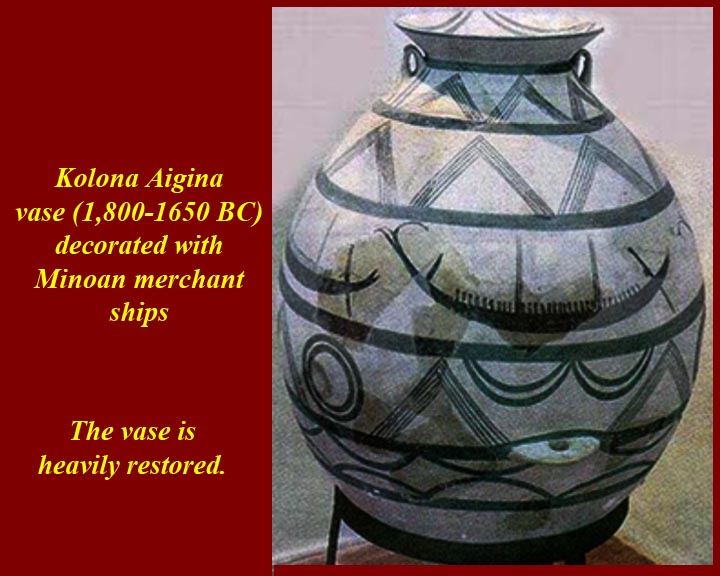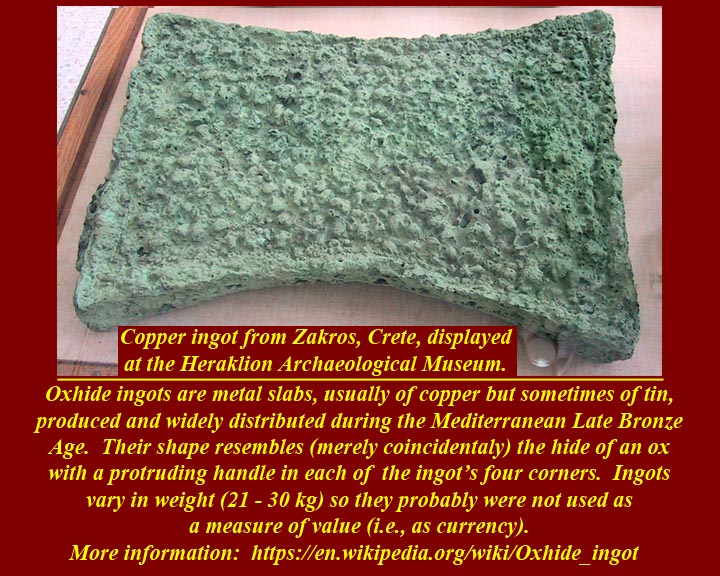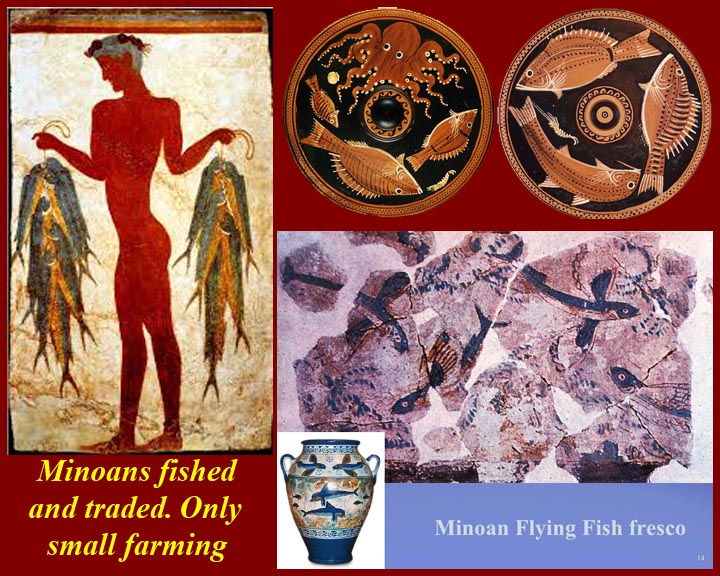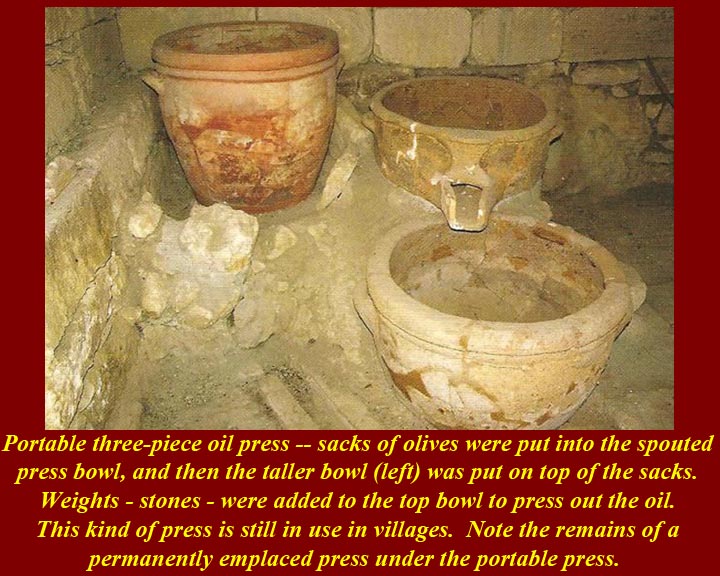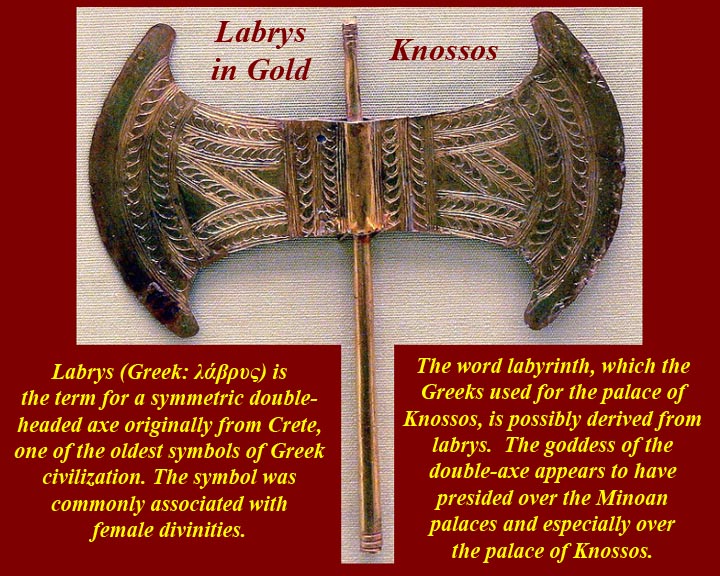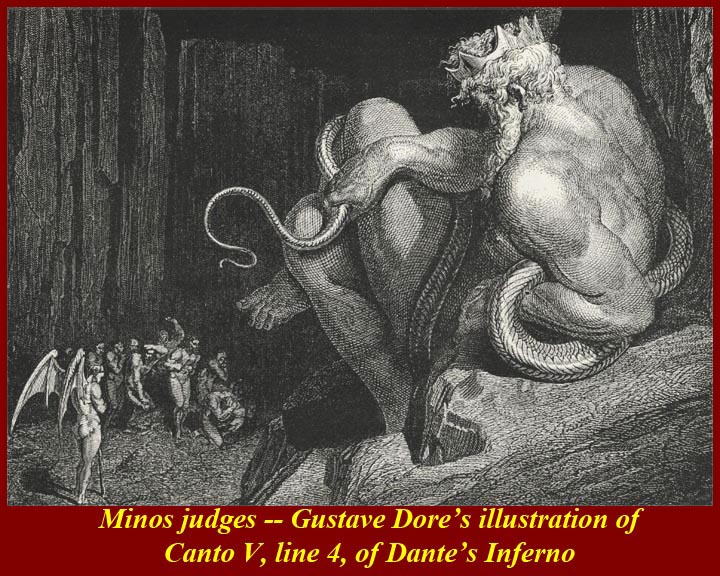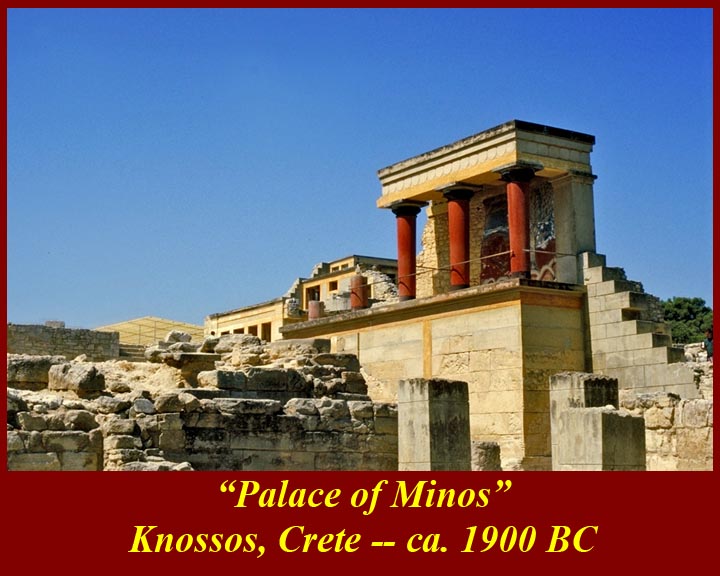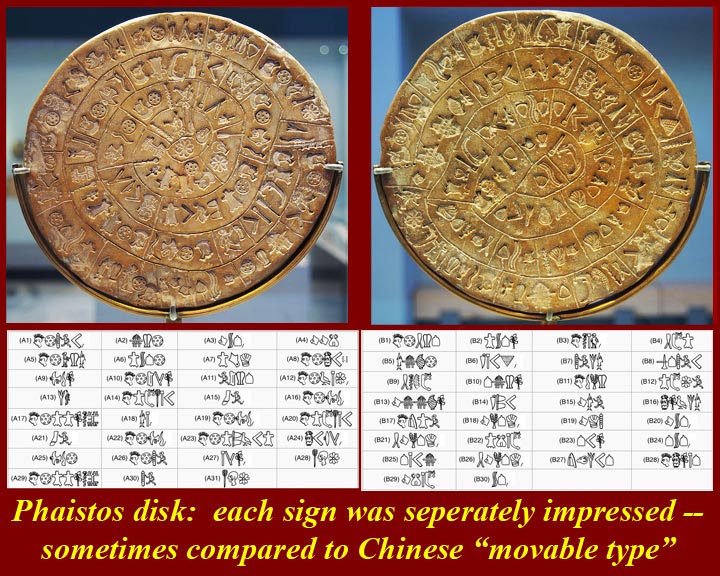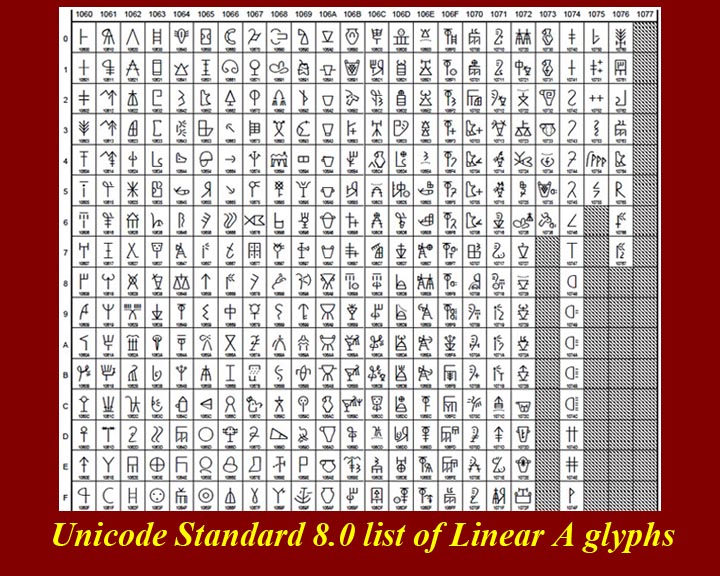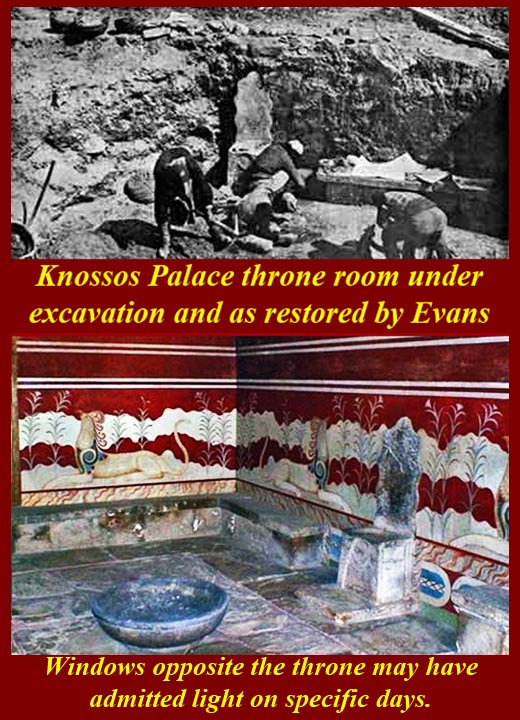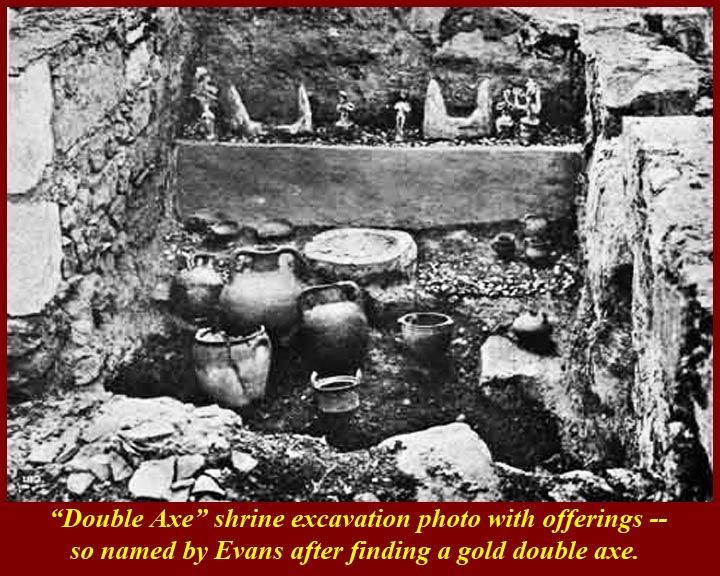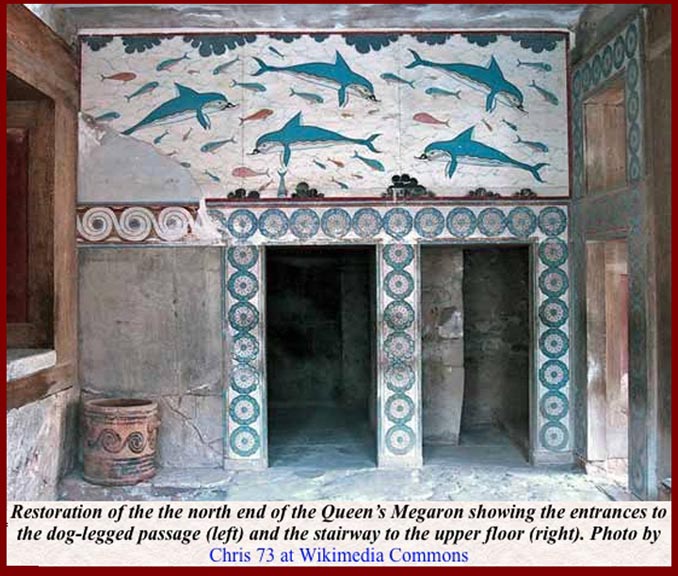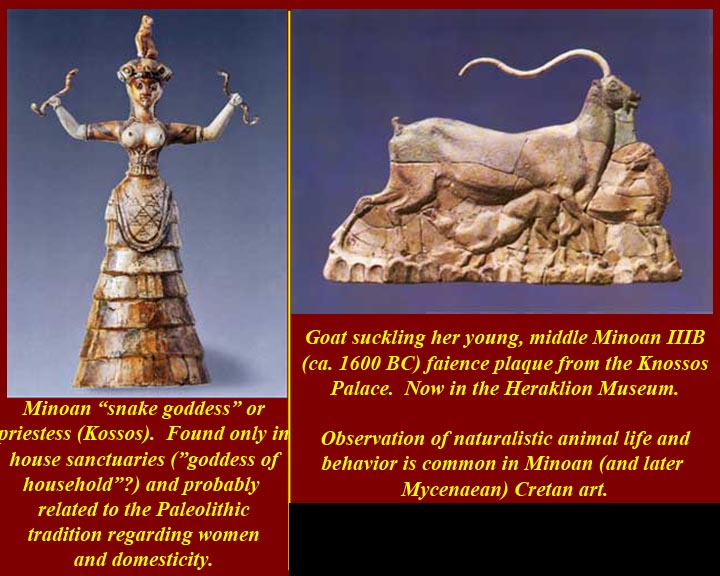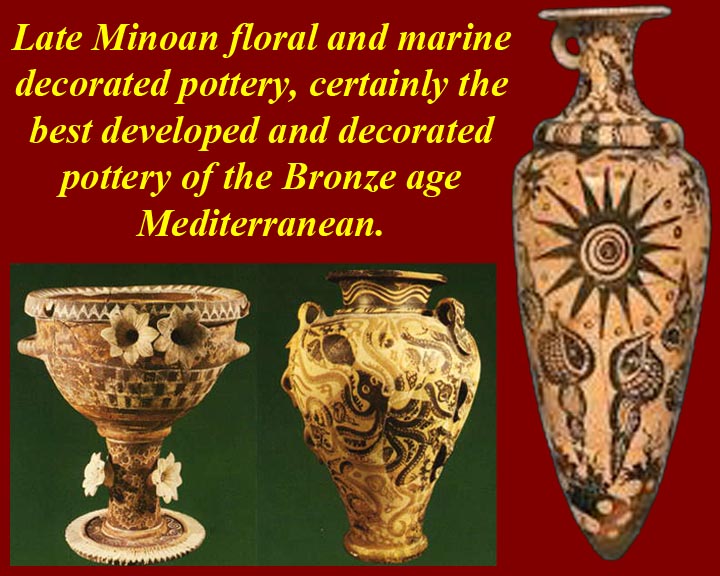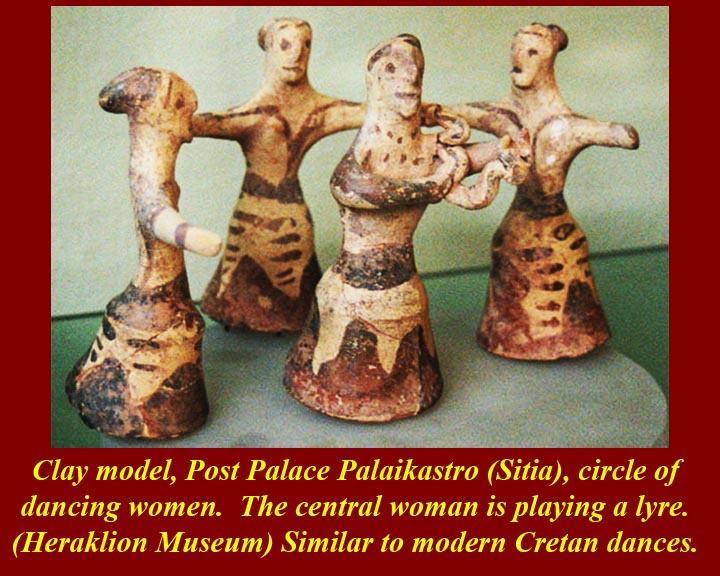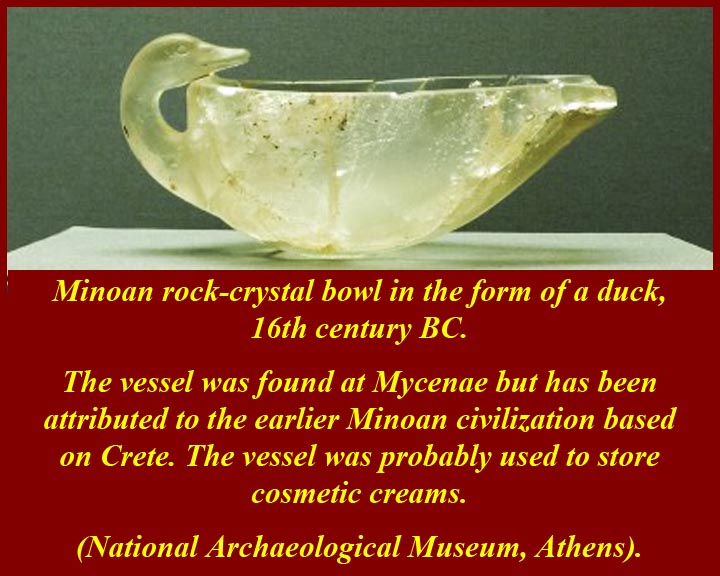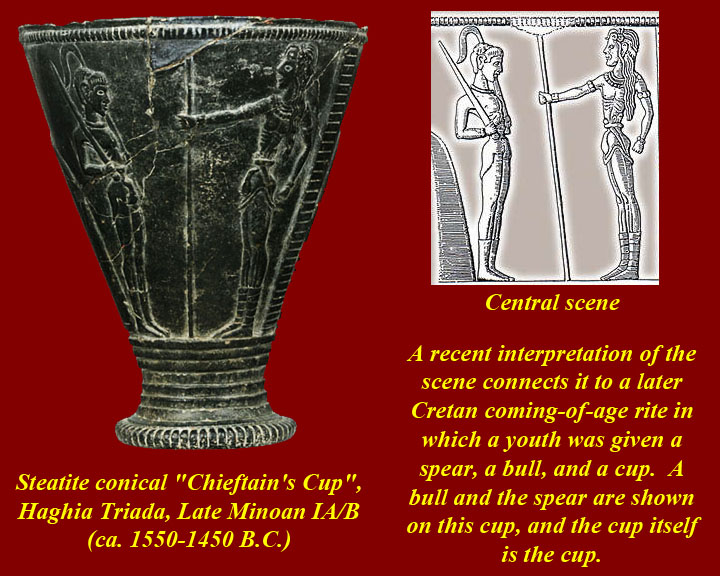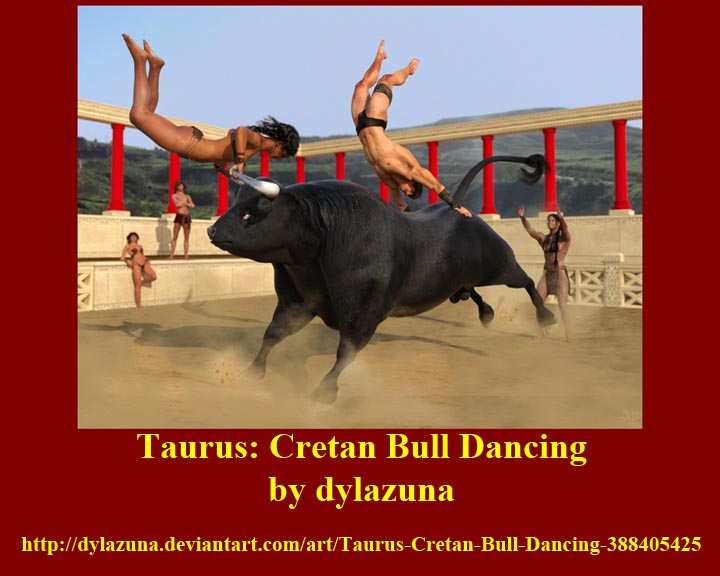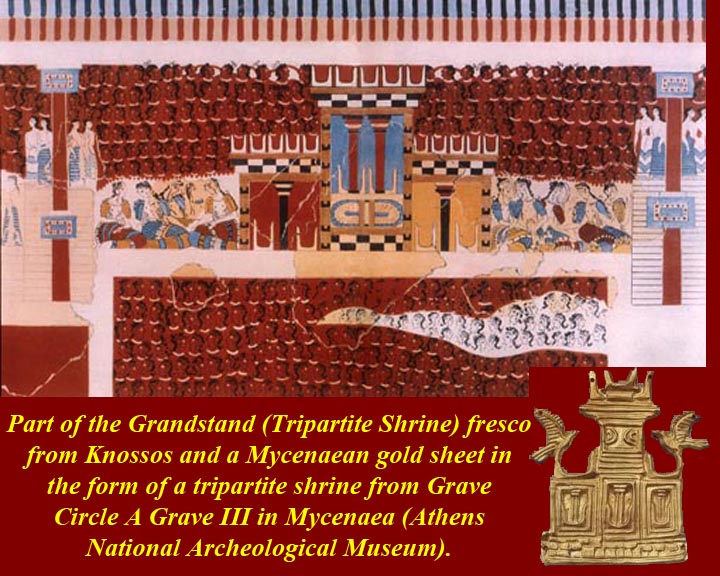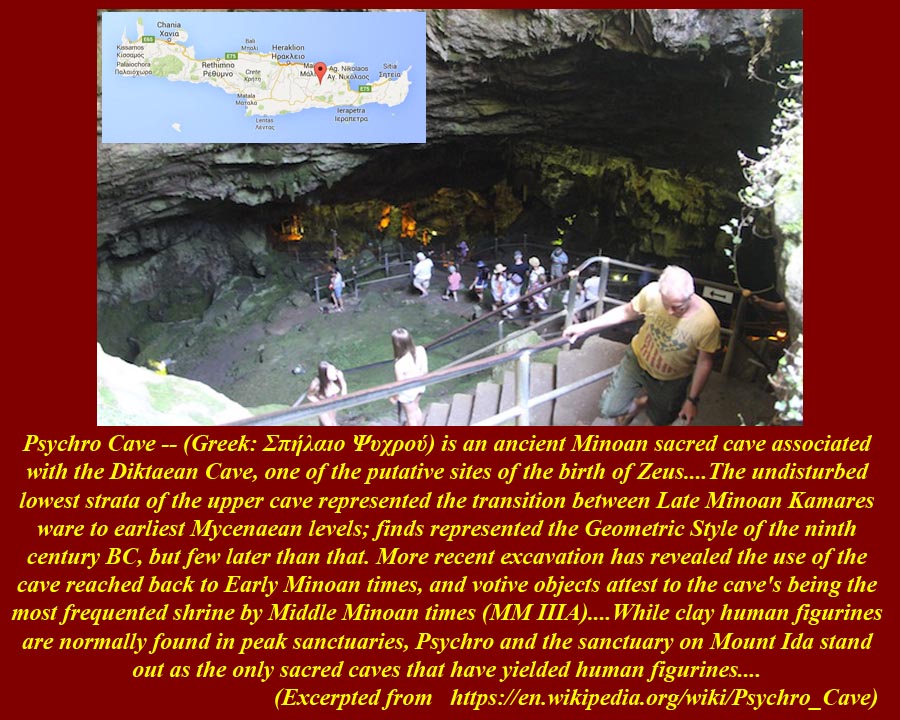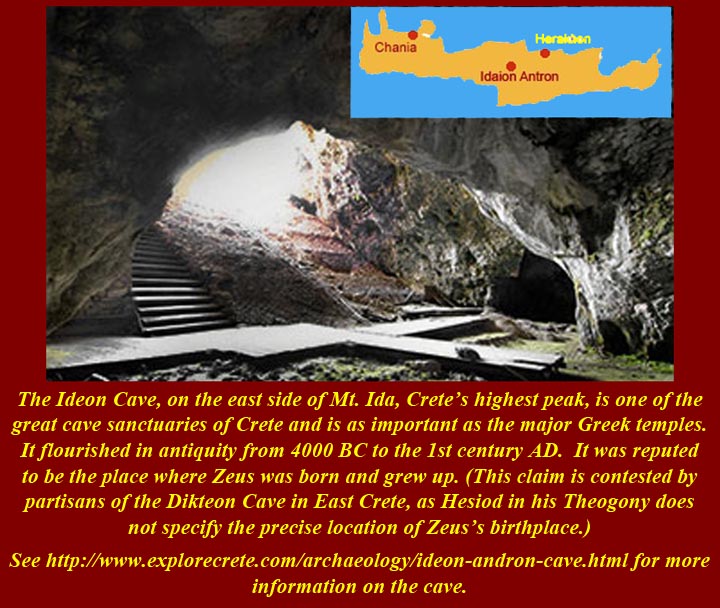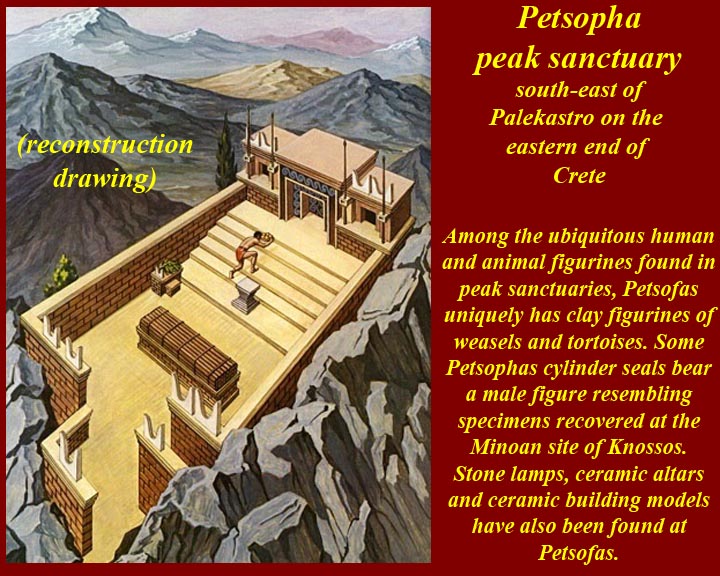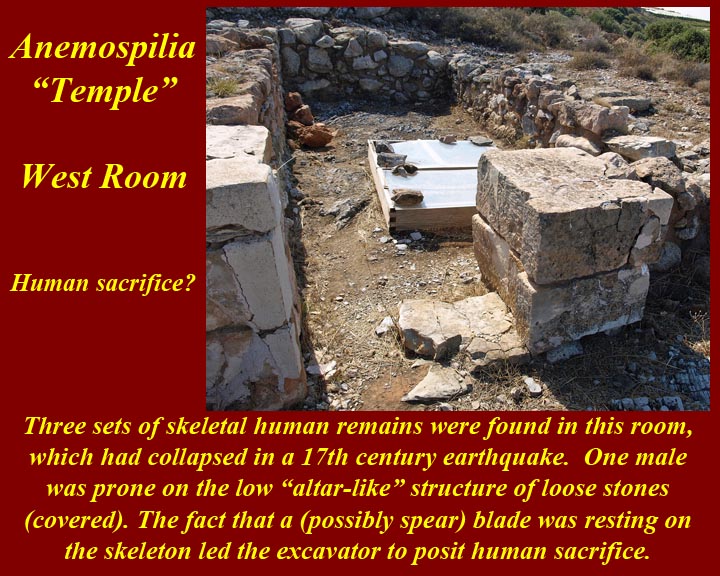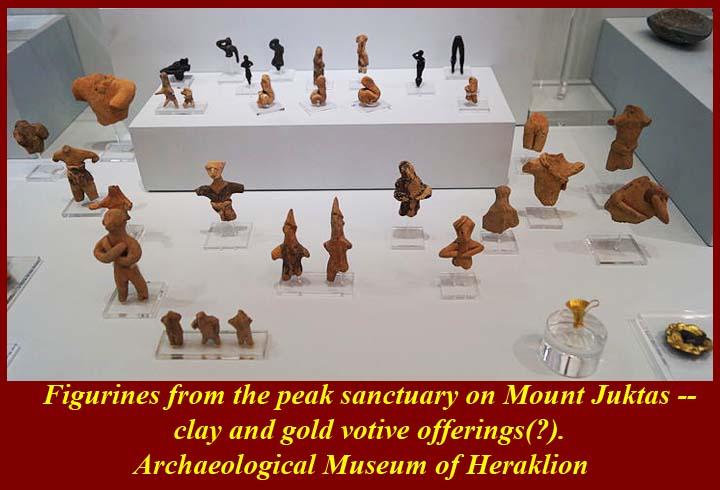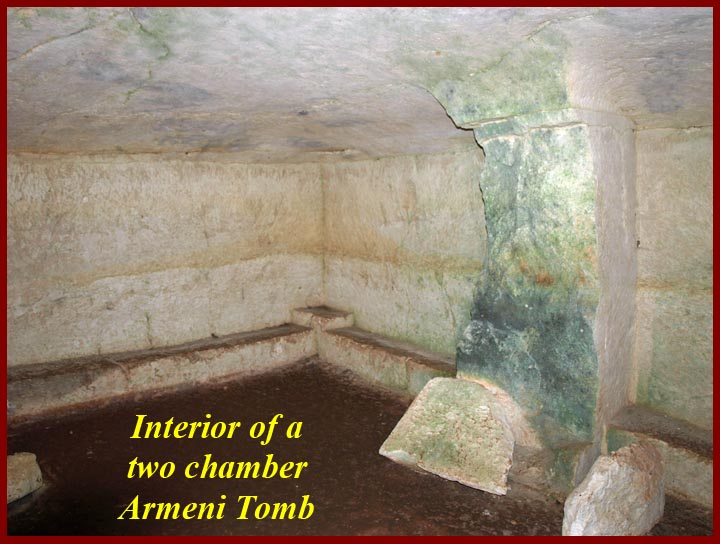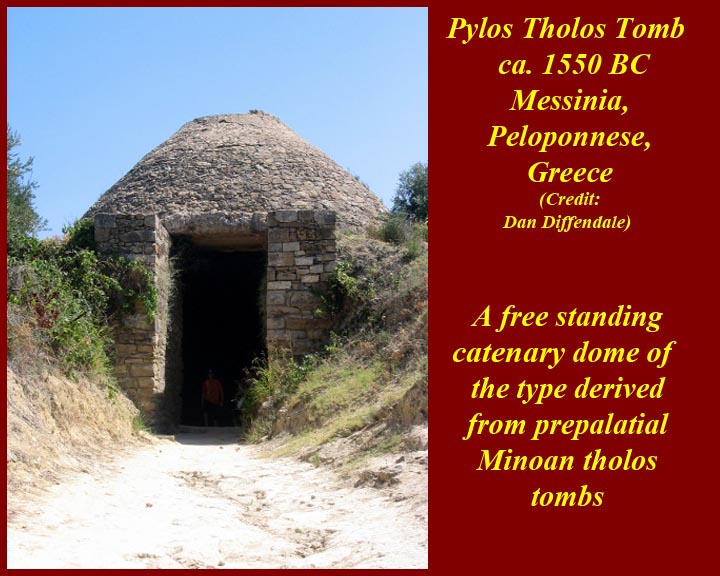Ancient Greece 1
Unit 2 -- The Minoans: First Great Aegean Civilization and Greek Precursor
(Following are excerpts from https://en.wikipedia.org/wiki/Minoan_civilization)
The Minoan civilization was an Aegean Bronze Age civilization that arose on the island of Crete and other Aegean islands such as Santorini and flourished from approximately 2600 to 1400 BC. It was rediscovered at the beginning of the 20th century through the work of British archaeologist Arthur Evans....
There is recent stone tool evidence that humans - either prehuman homonids or early modern humans - reached the island of Crete perhaps as late as 130,000 years ago; however, the evidence for the first anatomically modern human presence dates to 10,000-12,000 years ago. It was not until 5000 BC in the Neolithic period that the first signs of advanced agriculture appeared in the Aegean, marking the beginning of civilization....
The term "Minoan" refers to the mythic "king" Minos of Knossos; who first coined the term is debated. It is commonly attributed to famed Minoan archeologist Arthur Evans (1851-1941). Minos was associated in Greek myth with the labyrinth, which Evans identified with the site at Knossos. However, Karl Hoeck used the name Das Minoische Kretas in 1825 for Volume II of his major work, Kreta, which would appear to be the first known use of the term Minoan to mean ancient Cretan. Likely, Arthur Evans read the book, continuing the use of the term in his own writings and findings. Evans said:
"To this early civilization of Crete as a whole I have proposed — and the suggestion has been generally adopted by the archaeologists of this and other countries — to apply the name 'Minoan.'"Evans claims to have applied it, but not to have invented it....
_______________________________________________________________________
Click on small images to see a larger version.
Crete (Greek: Κρήτη, Kríti ['kriti]; Ancient Greek: Κρήτη, Krḗtē) is the largest and most populous of the Greek islands, and the fifth-largest island in the Mediterranean Sea. It lies 95 km away from Europe, 179 km away from Asia and 284 km away from Africa.
It was once the center of the Minoan civilization (c. 2700–1420 BC), which is currently regarded as the earliest recorded civilization in Europe.
Map showing the key archeological sites of the Minoan culture.
An archaeological culture is a recurring assemblage of artifacts from a specific time and place, which may constitute the material culture remains of a particular past human society. The connection between the artifacts is based on archaeologists' understanding and interpretation and does not necessarily relate to real groups of humans in the past. The concept of archaeological culture is fundamental to culture-historical archaeology. In Archeology jargon, "material culture" is the physical evidence of a culture in the objects and architecture they make, or have made. "Culture-historical archaeology" is an archaeological theory that emphasizes defining historical societies into distinct ethnic and cultural groupings according to their material culture.
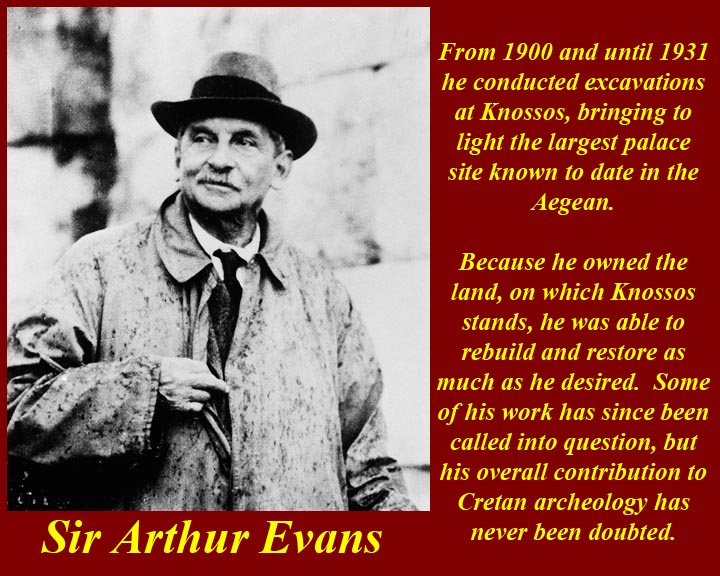
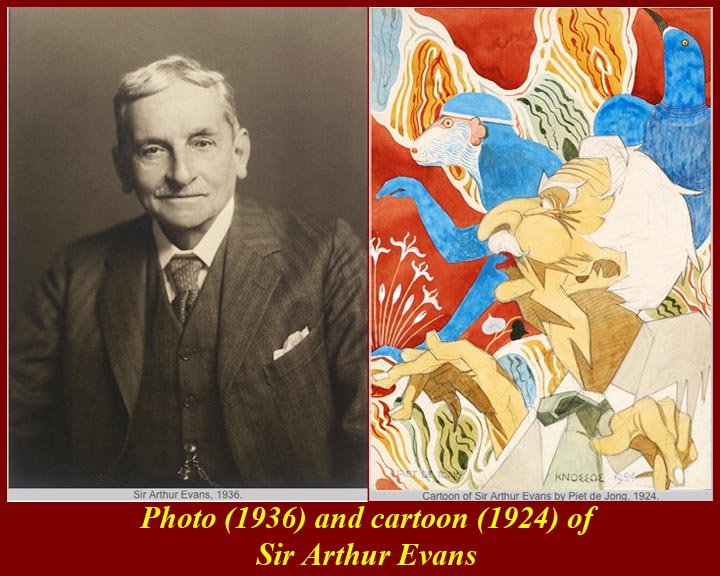
Sir Arthur Evans was the first excavator and rediscoverer of the Minoan culture. Starting in 1900 and until 1931 he excavated and restored Knossos, the site of the largest known "palace" site in the Aegean. Because he owned the land on which Knossos stood, Evans was unrestricted in his efforts to rebuild and restore the site. Some of his work has since been called into question, but his overall contribution to Cretan Archeology has never been doubted.
The image shows Evans' chronology based on stages of development during "early" (EM), "middle" (LM), and "late" (LM) phases of Minoan culture -- a standard archeological method often associated with levels found during excavation. (During digs, of course, it is "top down" -- the first level exposed will correspond to "late", and the last level exposed (from the bottom of the pile, lying on an undisturbed base) will be "early".
An alternative chronology (Nicholas Platon's) is based on development of Minoan "palace" complexes.
The graphic in the image is from https://en.wikipedia.org/wiki/Minoan_civilization.
Santorini, on the volcanic Island formerly known as Thera, was a thriving Minoan outpost. It is about 75 miles from Crete -- a distance, the importance of which, as it turned out, was tragically short for the Minoans.
What were the neighbors up to? The image showswhat was happening in mainland Greece and in Egypt during Early, Middle, and Late Minoan phases. "Helladic" refers to what was going on in mainland Greece (and corresponds to "Cycladic" a similar development stage on the Cyclades Islands. The main Helladic development in the late Helladic years was the Mycenaean culture, the subject matter of the next unit.
The Minoans became great "international traders" (in quotes because "nations" were still millennia away) shipping out olive oil, cloth, pottery, and finished metalwork. (Cretan pottery, metal products, and artistic influences were everywhere from Spain to Egypt. What they traded for was almost exclusively metals -- copper, tin, gold, less silver -- and ivory and alabaster and precious and semi-precious stones from Egypt, all as raw materials. Minoan port cities included many workshops that took the raw materials and made finished products for Minoan and foreign sale/distribution.
Maritime trade, naturally, required a military fleet for protection. The Minoans ruled the seas.
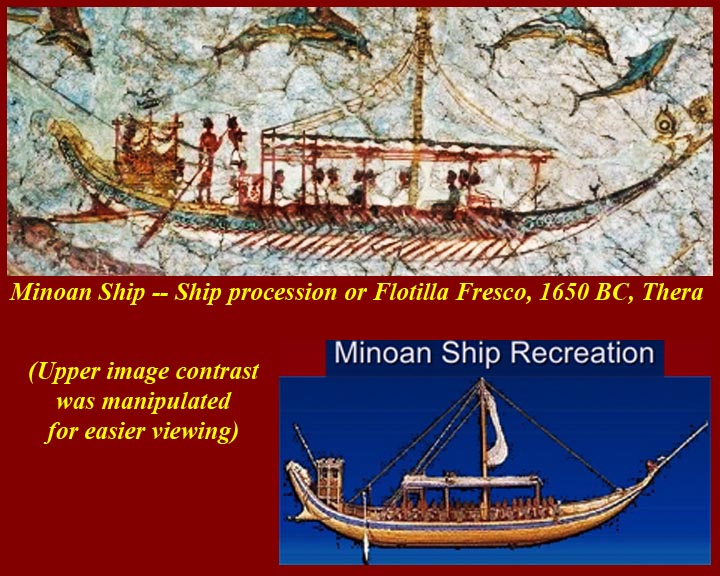
Images of Minoan trading vessels.
For everything you could possibly want to know about Aegean ships, see http://www.salimbeti.com/micenei/ships.htm.
For information on recovery of pottery from the first discovered underwater Minoan shipwreck site, see http://bookmarking.usrs0.com/look/Minoan_Ships/First_Minoan_Shipwreck__Archaeology_Magazine_Archive/aHR0cDovL2FyY2hpdmUuYXJjaGFlb2xvZ3kub3JnLzEwMDEvZXRjL21pbm9hbl9zaGlwd3JlY2suaHRtbA==_blog.
A copper "oxhide" ingot from Zakro, Crete. Copper and tin oxhide ingots weighing about 25 kilograms were traded extensively around the eastern Mediterranean. The "oxhide" name comes from the shapes of the ingots which resembled the shapes of stretched out oxhides. Weights of the ingots were not standardized and even within shipments could vary by seven or eight kilograms. The weight variations delegitimize any idea that they represented the value of an ox or that they were ever used as currency (i.e., no 25 kilo "coins").
For an account of the discovery/partial recovery of cargo of the Uluburun bronze age shipwreck (including ten tons of copper ingots and one ton of tin ingots -- enough to make eleven tons of bronze) off the south coast of Turley see https://en.wikipedia.org/wiki/Uluburun_shipwreck.
For information about the spread of bronze age metals technology, including sources of copper, in the Mediterranean and European areas, see https://en.wikipedia.org/wiki/Bronze_Age.
For information on tin sources, see https://en.wikipedia.org/wiki/Bronze_Age.
Any seafaring culture worth its salt would also be great fishermen. Minoan art and dinnerware demonstrated an intimate knowledge of what was edible in surrounding waters.
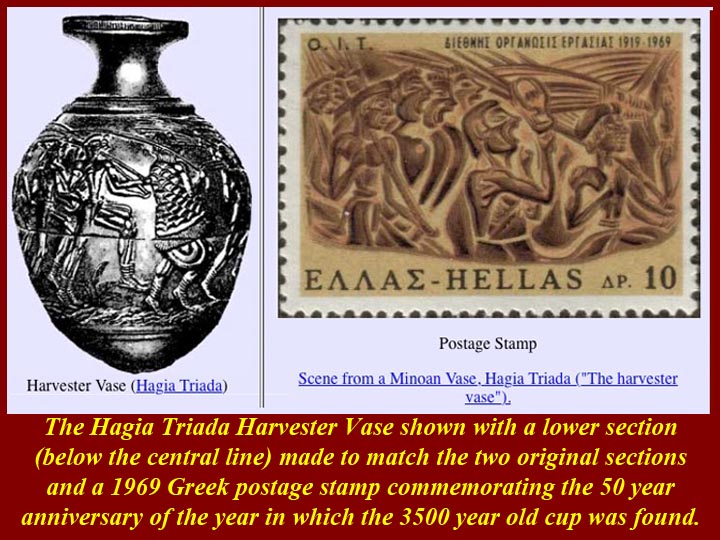
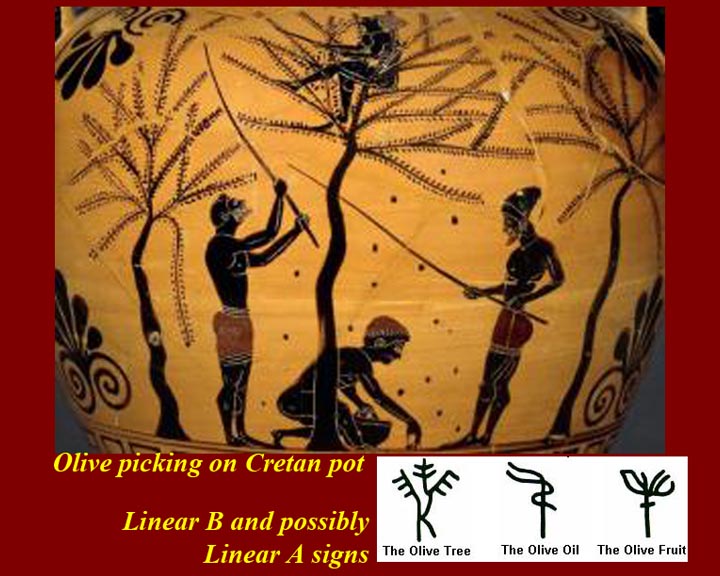
Agriculture was not completely neglected. You can't eat your fish without bread and oil in which to fry the fish. In addition, olive oil was an export item. The olive oil press illustrated displayed at Vathypetro would not be large enough to support trade, but the older press on which it stands is considered to be the oldest oil press in Europe.
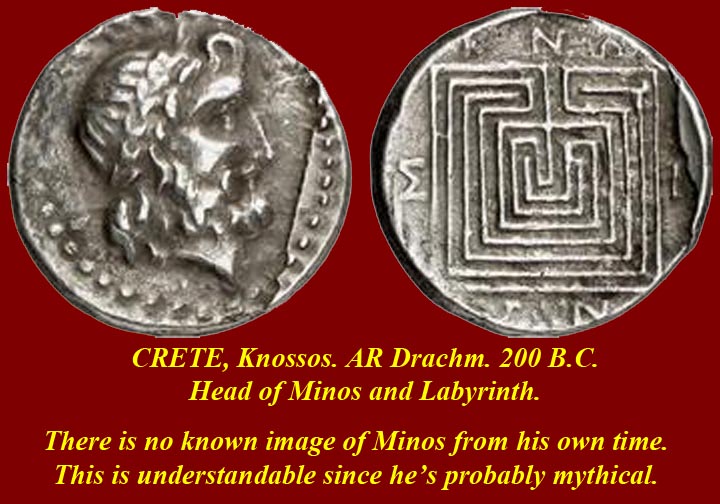
Evans was not the first to call early Cretans Minoans, but he certainly was the first to apply that name to the folks of his newly rediscovered civilization. Naming primacy is something all scholar-scientists worry about incessantly, even if the person or thing denominated is hung with the monicker if a Mythical tyrant. The obverse Minos image on the much later coin is also mythical.
The labyrinth on the reverse is equally dodgy. The word is probably derived from labrys a double axe, the ceremonial version of which is associated with Cretan goddesses, who were the protectresses of "Palaces". Later Greeks called the Knossos Palace the Labyrinth, because it was protected by a labrys toting goddess. Because of its many and rooms and confusing passages (in three dimensions -- supposedly built by Daedalus for King Minos), the word labyrinth eventually became associated with mazes of the kind shown.
(a.)(b.)
(c.)
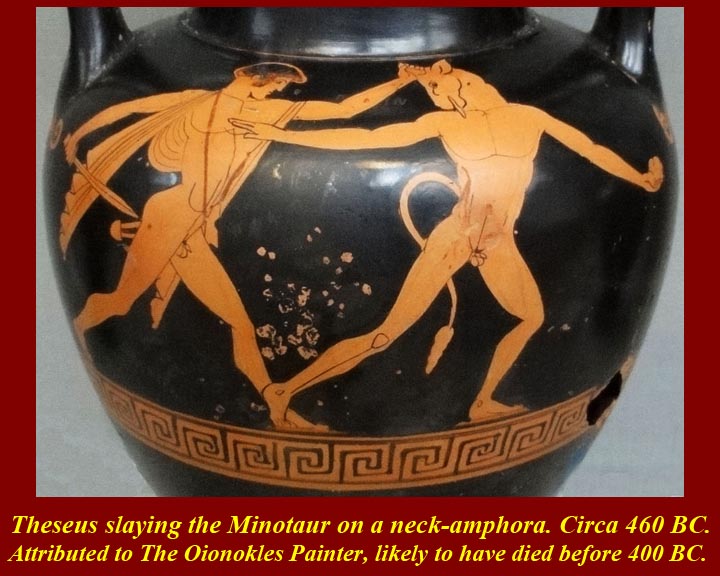
Legends about Minos proliferated in ancient times.
In (a.) Minos besieged the walls of Scylla's father's city. She saw Minos, fell immediately in love, and offered to betray the city. Minos was appalled and rode away leaving the city unconquered and Scylla lovelorn.
In (b.) we see the result of Minos's penny pinching. He owed Zeus the sacrifice of a prize bull, but he substituted and inferior animal. As punishment, Zeus induced Pasiphae, the wife of Minos, to fall in love with the bull and to want to receive it. She got Haephestos (or, in some versions, Daedalus) to help her by building a framework covered with a cow hide. She got inside and the bull mounted her in her disguise. The offspring was, inevitably, the Minotaur, who is seen in the stern archetypical "Virgin and Child" pose with her baby bullboy.
(c.) shows Theseus slaying the Minotaur after volunteering to be one of the fourteen male and female virgins demanded as Minotaur chow. Ariadne the daughter of Minos helped Theseus out (that is, actually out of the labyrinth) by providing the thread that he could follow back after killing the half-breed. Theseus eloped with Ariadne but abandoned her in on Naxos Island. Hundreds of possible alegoric explanations for the myth have been suggested (usually by graduate students), but none is any more likely than any other. Maybe Theseus just didn't like bull.
The legendary first Minos stayed legendary even in death, where he became the judge who had to determine if the records of lives were accurate and to decide on punishments. Dante Places Minos at the entrance of the second level of hell (-- see http://www.bartleby.com/20/105.html for an English translation).
An apt explanation of Dante's usage of Minos is at http://danteworlds.laits.utexas.edu/circle2.html
"Typical of the monsters and guardians of hell, Dante's Minos is an amalgam of figures from classical sources who is completed with a couple of the poet's personal touches. His Minos may in fact be a combination of two figures of this name--both rulers of Crete--one the grandfather of the other. The older Minos, son of Zeus and Europa, was known--because of his wisdom and the admired laws of his kingdom-- as the "favorite of the gods." This reputation earned him the office-- following his death--of supreme judge of the underworld. He was thus charged, as Virgil attests, with verifying that the personal accounting of each soul who came before him corresponded with what was written in the urn containing all human destinies: "He shakes the urn and calls on the assembly of the silent, to learn the lives of men and their misdeeds" (Aen. 6.432-3). The second Minos, grandson of the first, exacted harsh revenge on the Athenians (who had killed his son Androgeos) by demanding an annual tribute of fourteen youths (seven boys and seven girls) as a sacrificial offer to the Minotaur, the hybrid monster lurking in the labyrinth built by Daedalus.
"Minos' long tail, which he wraps around his body a number of times equal to the soul's assigned level (circle) of hell (Inf. 5.11-12), is Dante's invention. How do you think the judged souls travel to their destined location in hell for eternal punishment? Might Minos' tail be somehow involved in this unexplained event? Dante leaves this detail to our imagination.
"The original Italian of the first line describing Minos --"Stavvi Minòs orribilmente, e ringhia" (Inf. 5.4)--is a wonderful example of onomatopoeia (the sound of the words imitating their meaning) as the repeated trilling of the r's in "orribilmente e ringhia" evokes the frightening sound of a growling beast."
Regardless of who Minos was (or whether he was), someone or some series of someones must have been in charge of the construction and then reconstruction of the labyrinthine Knossos compound that Evans dubbed a "Palace". More on the Palace is below, but first,
Language:
The language of the Minoans is quite unknown, although it probably was encoded in two forms of writing, which Evans called Cretan Hieroglyphs and Linear A.
Linear B encodes an ancient form of Greek (and will be covered in the next Unit with the Mycenaeans) and has much in common with Linear A, and individual signs may have the same pronunciation. But, if that is the case, in combination the Linear A sounds produce "words" in no known language. Several theories about what various Linear A samle say and mean have been put forward, but none is really definitive or persuasive.
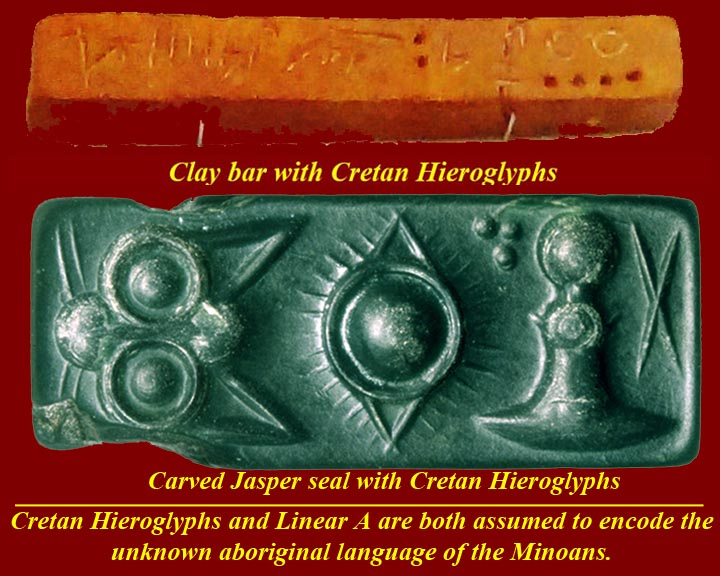
Samples of Cretan Hieroglyphs incised in clay and carved in jasper.
In the second image are both sides of the "Phaistos Disk", which has been ordered and parsed but which is nonetheless still untranslatable. The Phaistos disk signs were individually impressed on both sides before firing (an implausible task in itself; the disk is about six inches in diameter and less than a half inch thick). Use of the impression process has been compared with the Chinese invention of moveable type.
For more on the Phaistos Disk, see https://en.wikipedia.org/wiki/Phaistos_Disc.
For information on Cretan hieroglyphs, see https://en.wikipedia.org/wiki/Cretan_hieroglyphs.
Using any Internet search engine, you can find tons of information and misinformation on both.
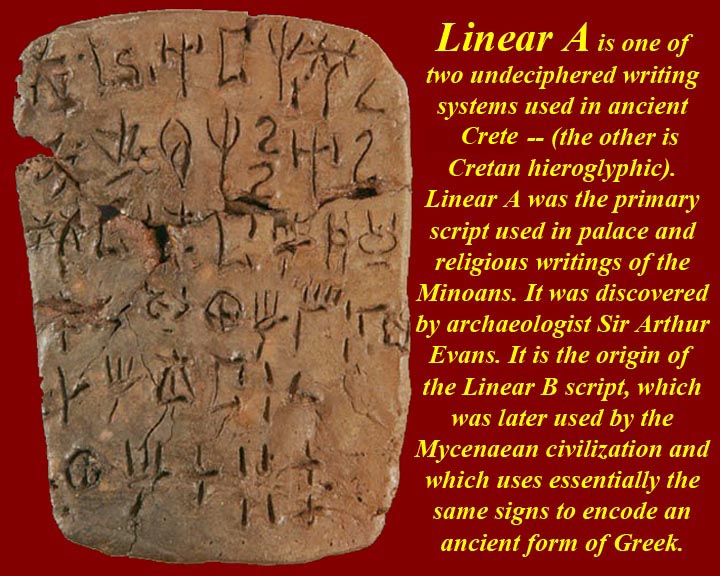
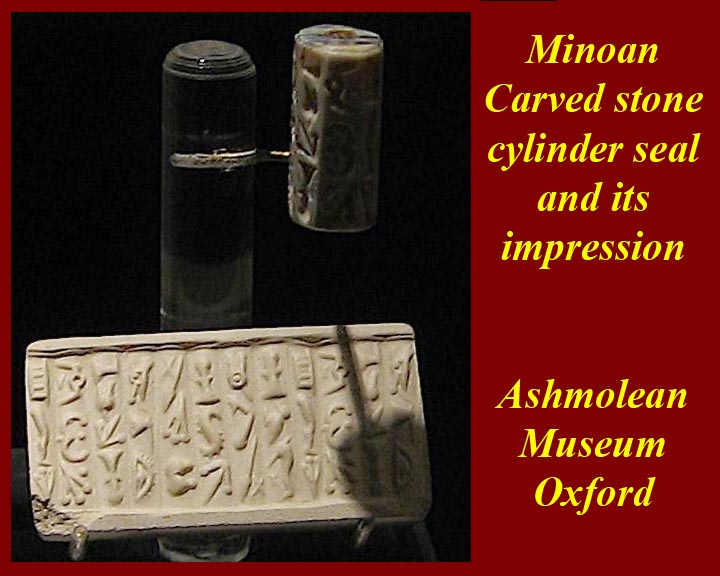
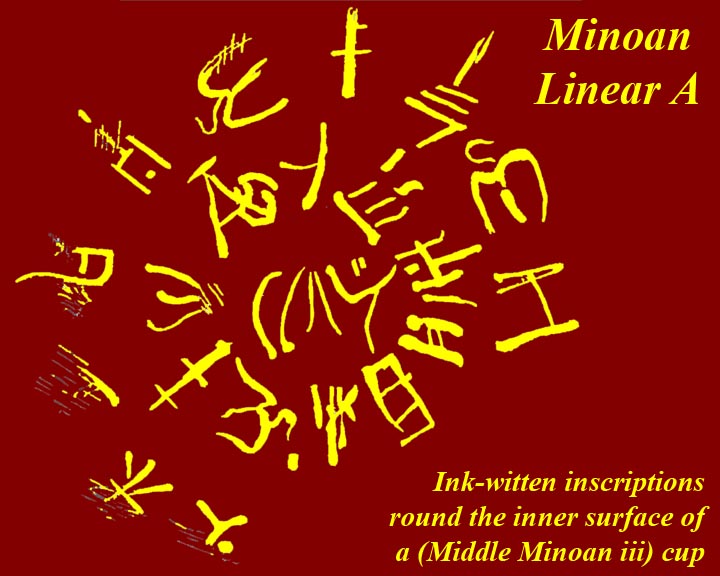
Samples of the unreadable Linear A script and a list of Linear A signs.
Palaces:
From http://www.explorecrete.com/archaeology/minoan-palaces.html
The Minoan Palaces known to date in Crete are those of Knossos (22,000 m2), Phaistos (18,000 m2), Malia (7,500 m2) and Zakros (8,500 m2 ). All the Minoan palaces excavated so far are in east Crete. In west Crete the existence of the Minoan palace of Kidonia in Chania is known, but it has not been excavated because it is located in the town centre (Kastelli Hill), in a densely-populated area.Other Palaces:
The Minoan palaces were autonomous and independent from each other, but they appear to have followed a common policy dictated by the central, larger and more sumptuous palace of Knossos.
The Minoan palaces played an active role in all the activities of Minoan society, adapting to multiple demands with various functions.
Galatas ---- Petras ---- Monastiraki
Also see http://www.athenapub.com/11palace.htm, and
http://whc.unesco.org/en/tentativelists/5860/
The Knossos "Palace" is the largest, most studied, and most restored. Examples of architecture and arts and artifacts from Knossos are representative of, if not better than, those from other sites.
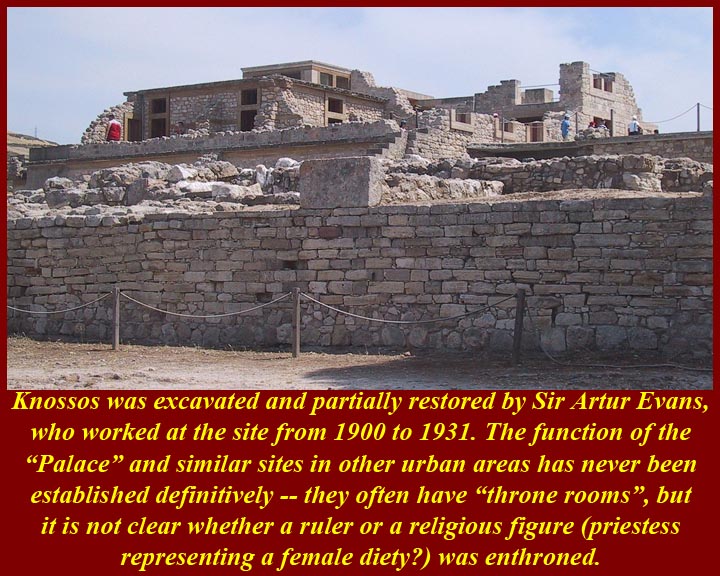
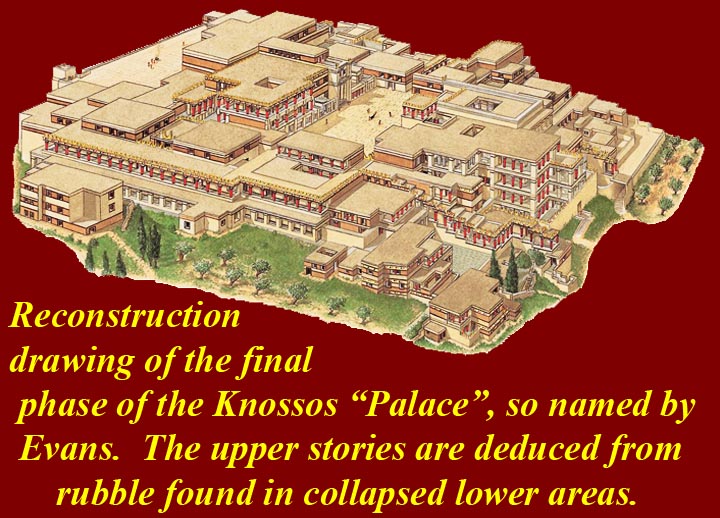
The Knossos "Palace" ruins and an artistic reconstruction of the palace in its final phase.
See http://www.minoancrete.com/knossos.htm.
Knossos Palace throne room during excavation and after restoration. Archeological purists alwys decry restoration, but an at least partially restored site attracts visitors, and if done intelligently, it can both protect the site (by, for examle, adding/replacing roofing) and add to the site's didactic usefulness. There are, of course, possible pitfals to restoration -- older, more deeply buried art and artifacts may become sealed in under the resstoration level, and newer information may be found that could change the details of restorations.
Also see https://en.wikipedia.org/wiki/Throne_Room,_Knossos.
Knossos "Double Axe Shrine" photo taken after fallen rubble was removed but before removal of artifacts, which were/are assumed to be votive items (some of which may have fallen from above).
The shrine is at the southeast corner of the Knossos Palace central court.
From http://www.odysseyadventures.ca/articles/knossos/articleKnossos10.eastWing-02.html (which also has a diagram showing the location of the finds within the "shrine"):
The southern part of the East Wing is an area of small rooms and corridors that appears to have been religious in character. There are storerooms and magazines, lustral basins and light-wells. Fragments of painted plaster and pieces of stucco relief suggest that there was an important hall or set of rooms upstairs but the only actual cult room that Evans found is the Shrine of the Double Axes.
The room is tiny, barely a metre-and-a-half square, with a plastered clay bench at the back. It was installed, according to Evans, by squatters who reoccupied the site of the palace shortly after its final destruction. On the bench was a pair of sacred horns with sockets to hold small bronze double-axes. Around them were a number of terracotta figurines—a goddess with upraised arms, a pair of priestesses cupping their breasts and a pair of male votaries. In front of the bench was a raised area, paved with water-worn pebbles, a tripod altar and a collection of LMIIIb vessels.
The restored hall of the "Queens megaron". A megaron (/ˈmɛɡəˌrɒn/; Ancient Greek: μέγαρον), plural megara /ˈmɛɡərə/, was the great hall of the Grecian palace complexes. It was a rectangular hall, fronted by an open, two-columned porch, and a more or less central, open hearth vented though an oculus in the roof above it and surrounded by four columns. If there were two great halls, Evans reasoned, the bigger would have been for the "King" and the lesser for the "Queen". His interpretation was helped by the fact that the decorations were kind of "girly" -- dolphins and dancing ladies. At the end of the room, a low partition wall with one column created a small space. It was thought that it was the "Queen's Bathroom" since pieces of a clay "bath" were found there.
The layout of megarons in the palaces forecast the eventual plan of Greek temples -- a columned entrance, then a pronoas, then a naos (cella).
See http://www.interkriti.org/crete/pg/?pg=1512315, and
https://en.wikipedia.org/wiki/Megaron.
Artifacts
The gold Knossos labrys is the showpiece of the Heraklion Museum and the centerpiece of a display of smaller votive gold and silver labra axes dating from the New-Palaca and Post-Palace periods (1700 - 1300 BC). The double axe in Crete, once the instrument of sacrifice of the sacred bull, became the main religious symbol of the Cretans (it is most often depicted together with the head of a bull). The Minoan name for the double axe is "labrys", thus the word labyrinth may originally have meant the "house of the double axe".
For an image of the Heraklion Museum display, see http://www.grisel.net/images/greece/Herakleion29_10.JPG.
For information about the Cretan origin of the labrys, see https://en.wikipedia.org/wiki/Labrys.
Ceramics/stone vessels
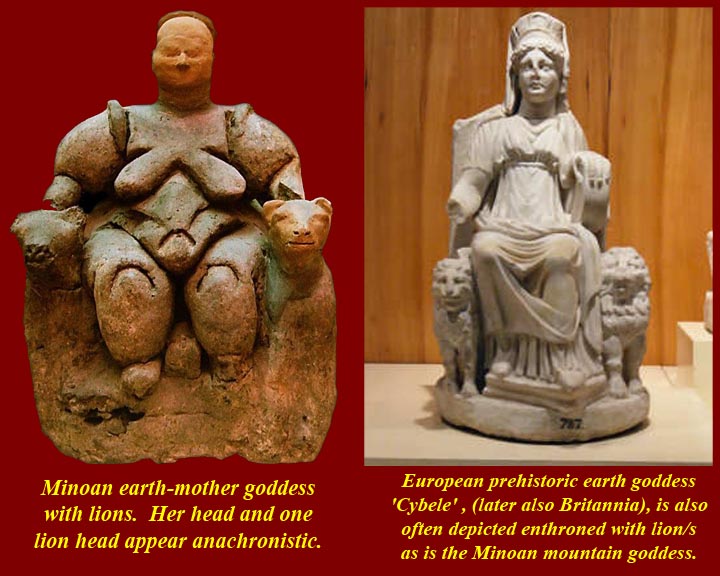
Statuettes, some very primitive, were preserved in Palace and mounain top shrines and often appear to have had something to do with female fertility/motherhood or with female deity protection -- It has never been decided whether the topless ladies holding snakes are supposed to be goddesses or priestesses. Perhaps if someone someday decodes Linear A, we will know.
See http://www.greek-thesaurus.gr/minoan-figure-photo-gallery.html and
http://www.academia.edu/1263966/Configuring_the_Individual_Bodies_of_Figurines_in_Minoan_Crete
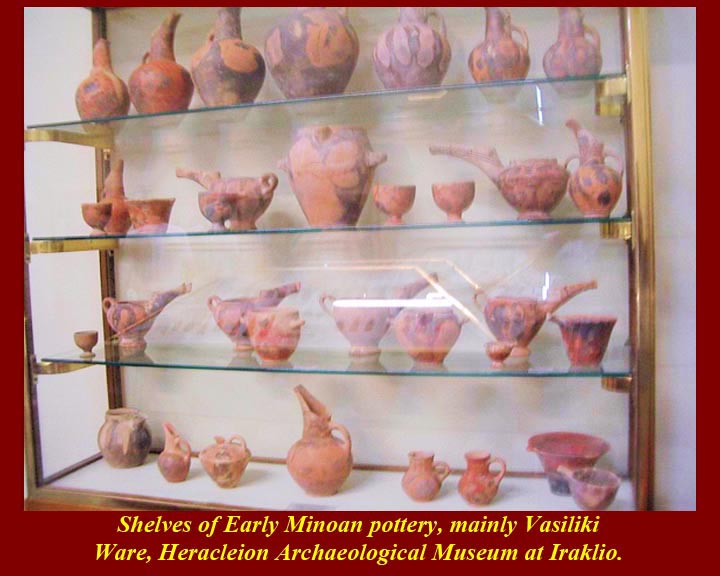
Pottery is the traditional way that archeologists establish chronologies, and classifying individual pots or sherds is a way both of determining where the piece fits into the chronology and of determining the age of a strata in which the piece is found. When styles ot types cross levels (particularly the case with non-decorative houseware pottery), more complex scientific processes can help with dating.
With decorative wares, it is not always true that more complex decorations succeed simpler forms -- sometimes there is degradation as societies weaken and/or are replaced. It is also possible that nostalgia for older/simpler times, religious "puritanism", or contact with outsiders can influence pottery styles. Just think about how Dutch ceramics (e.g., Delft wares) were influenced by the arrival of Guido da Savino in Antwerp in 1500, by new availability of foreign clays and cobalt (blue), and by contact with the Far East through the Dutch East india Company. Similar things happened to all Mediterranean pottery during the Bronze age. And, relatively speaking, Minoan pottery, just like Delft wares, had worldwide (i.e., known world) distribution
The traditional chronology for dating Minoan civilization was developed by Sir Arthur Evans in the early years of the 20th century AD. His terminology and the one proposed by Nikolaos Platon are still generally in use and appear in this article. For more details, see the Minoan chronology.
Evans classified fine Minoan pottery by the changes in its forms and styles of decoration. Platon concentrated on the episodic history of the Palace of Knossos. Fabric analysis, involves geologic analysis of coarse and mainly undecorated sherds as though they were rocks. The resulting classifications are based on composition of the sherds. Radioactivity measurements, sample luminescence, and rehydroxylation rates are all possible technological aids.
For much more on Minoan pottery, see https://en.wikipedia.org/wiki/Minoan_pottery.
There are more images of Minoan pottery on the Internet than you will ever want/need. To get started, typed the two words Minoan and pottery into your Internet image search engine.
A few Minoan ceramics and stone vessels deserve special mention:
Not quite, but almost unique in Minoan context, a ceramic group of female dancers
The steatite "Harvesters Vase" (actually probably a rhyton)A rhyton (plural rhytons or rhyta) is a container from which fluids were intended to be drunk or to be poured in a ceremony such as libation.
Minoan carved stone vesselsand,
from the right hand end in the previous picture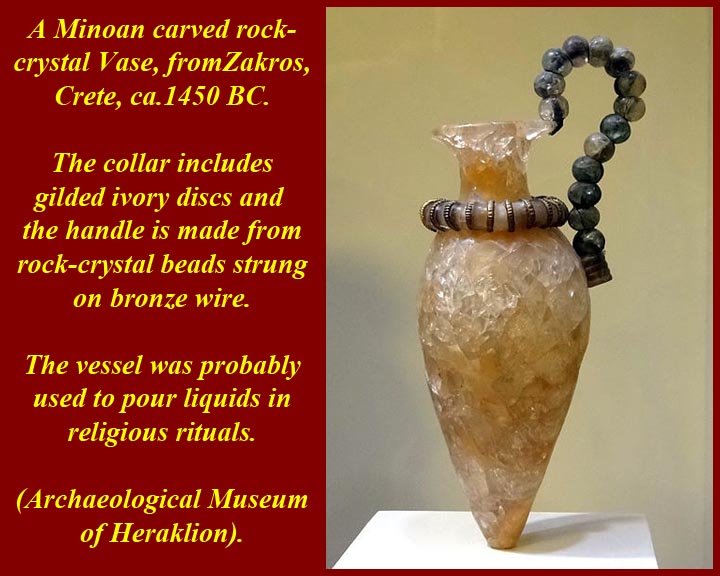
A very thin rock rock crystal duck shaped bowl
A steatite stone cup showing a probable maturity ritual
Frescoes
As is the case with pottery and stone vessels. there are very many images of Minoan frescoes on the Internet. Use your image search engine to find Minoan frescoes.
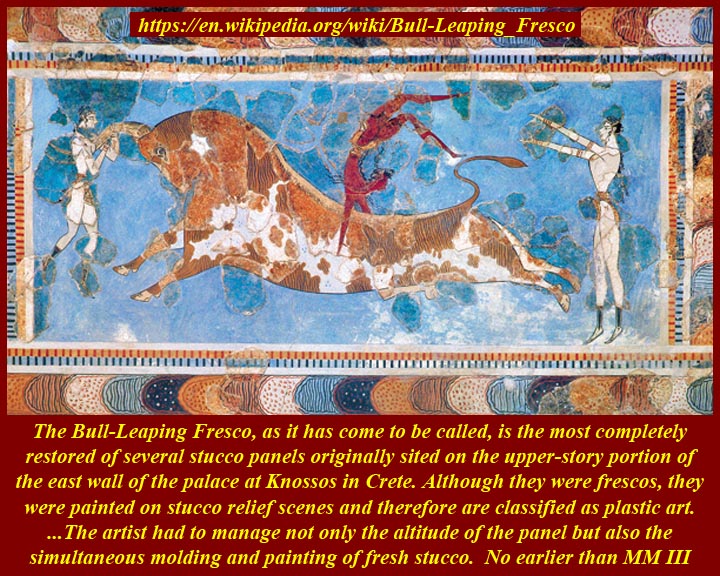
The most famous Knossos fresco and its modern computer graphic counterpart, a youth leaping over a bull with two female attendants. Initially there was some doubt about what Evans said was depicted, but more and more finds of the same motif convinced the naysayers.
Various modern human physiologists have weighed in saying that the feat shown is impossible, but they have probably never seen the Spanish "recortadores", available on the Internet at https://www.youtube.com/watch?v=yWwJJ1NraEg,
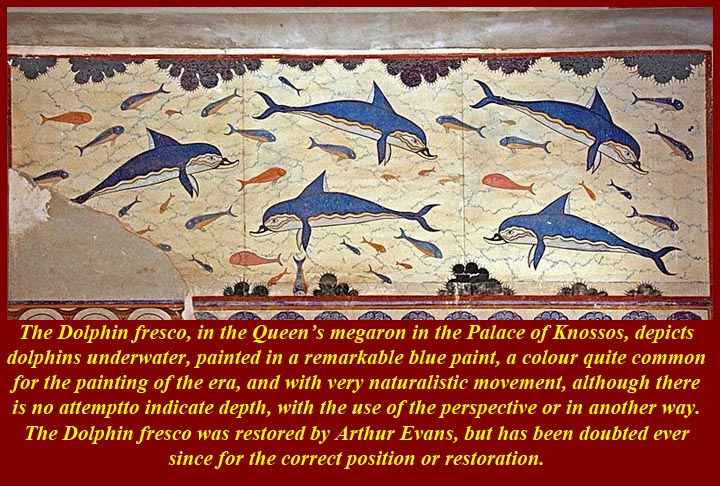
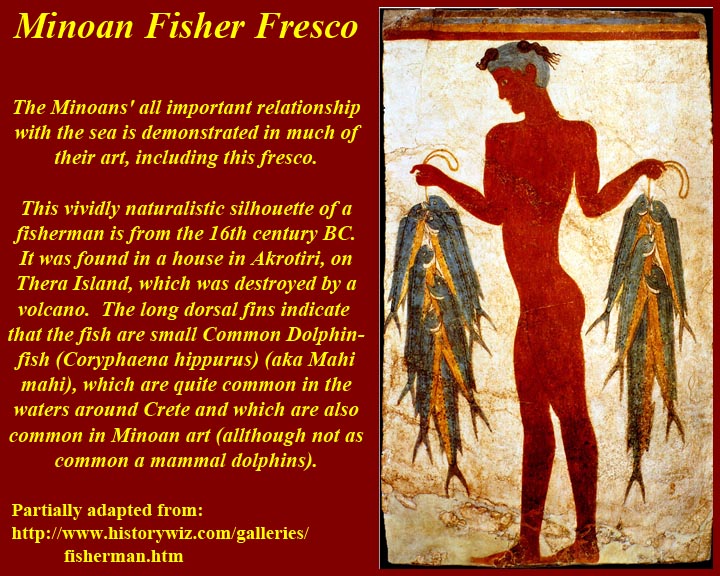
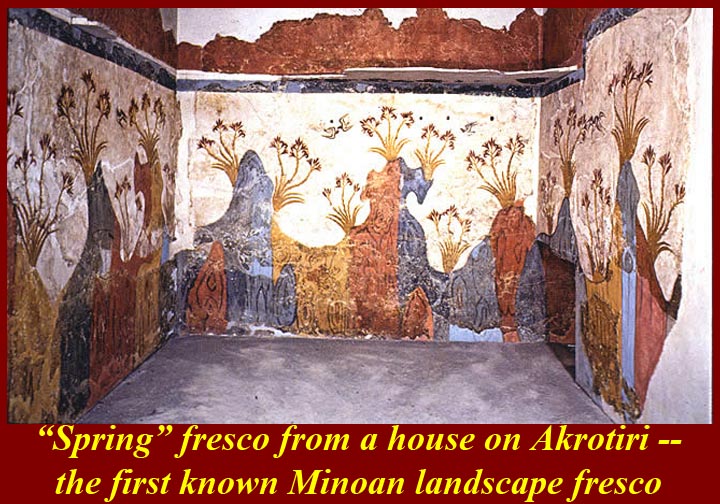
All of the frescoes shown are from the Knossos Palace. There are many more both at Knossos and at the other palatial complexes.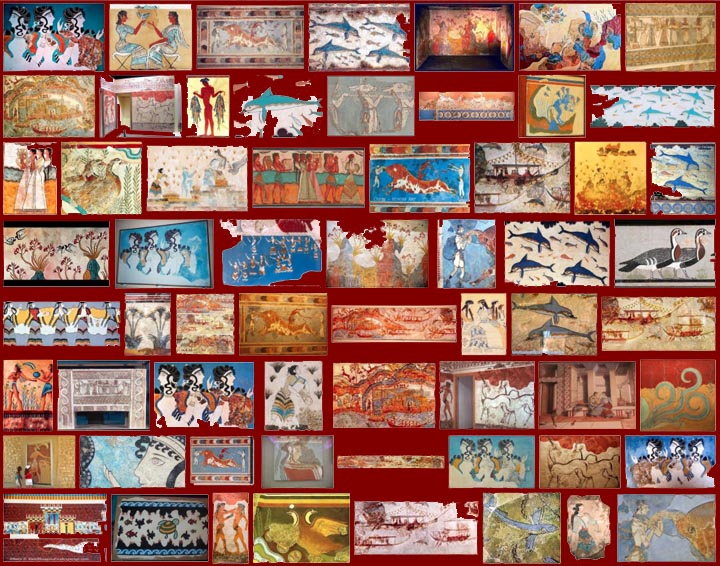
Use your image search engine to find Minoan frescoes.
Caves and Peak Sanctuaries
Minoan palaces and homes had their religious spaces, but there were also caves (originally pre-Palatial in origin but stretching onward into post-Christian times) and free-standing. There were also isolated mountain peak sanctuaries.
Psychro Cave (aka Dikteon Cave) is one of the most important and famous of the 3,000 caves in Crete. It is in the Mount Dicte range in East Crete, on the Lassithi Plateau. The area and probably the cave have been in use since neolithic times and is one of the few areas in the Mediterranean where settlements arose at such high altitude (an average of 840 m. above sea level). It is one of the two Cretan caves that claims to be the bithplace of Zeus (the other being the Ideon Cave.) The cave is visited by thousands of tourists.
See http://www.explorecrete.com/archaeology/dikteon-andron-cave.html and
https://en.wikipedia.org/wiki/Psychro_Cave, and
The Ideon Cave, like the Dikteon, is called the brthplace of Zeus (Hesiod in his Theogeny was none to clear about where the Old Boy was born and raised. This is the cave, however, that was most revered by the ancient Cretans. It was a pagan religios sight from Neolithic times until when paganis was eclipsed by Christianity in the first few centuries AD. It was visited by many ancient VIPs including Pythagoras who journaled his visit, describing in particular the Zeus altar still visible just outside the cave entrance. Although much more important during ancient times, the Ideon cave has lost the modern tourist attraction sweepstakes to the Dicteon Cave -- relatively few visit the Ideon today.
See http://www.explorecrete.com/archaeology/ideon-andron-cave.html and
https://en.wikipedia.org/wiki/Cave_of_Zeus.
Peak sanctuaries: (Petsophas reconstruction drawing) were places of pilgrimage for the Minoans. Numerous votive offerings, probably left as prayer requests, were recovered including, only at the Petsophas site, figurines of weasels and tortoises and other "pest animals", possibly used in apotropaeic rituals. Cylinder seals from Petsophas image a male figure similar to some from Knossos. Among other artifacts recovered at Petsophas were stone lamps, ceramic altars, and models of buildings. The ruins of Petsophas are a short distance outside (SE) the village of Palaikostro at the eastern tip of Crete.
Research has been done to try to connect siting and orientation of the Peak Sanctuaries with ancient astronomical observation and prediction.
See http://www.minoanastronomy.mikrob.com/pdf/1996%20Petsophas.pdf.
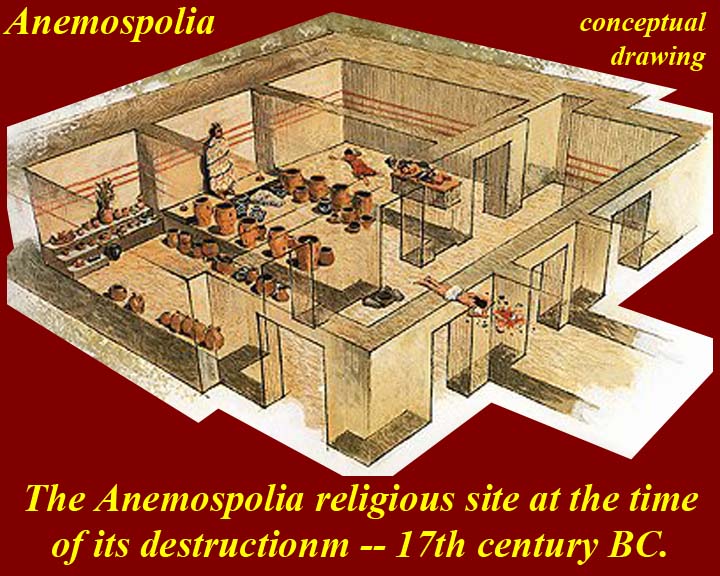
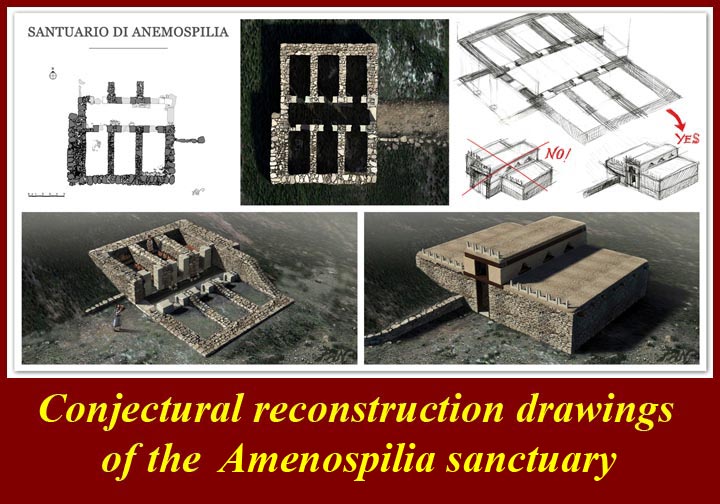
The Anemospilia Peak Sanctuary was formerly thought to have been a structure with three chambers and a corridor running across their front. Later investigations have led to the description of the sight as having two sets of three rooms seperated by the long corridor. Various purposes have been ascribed to the fuctions of individual rooms, but all are questionable. In addition to numerous artifacts and votive items, four sets of human remains were found in the ruins -- four people (two men, one woman, and one unknown due to its pelvis being pulverized) apparently caught in the earthquake and fire that destroyed the structure in 2,000 BC. The presence of a woman at the site calls into question the theory that Peak Sanctuaries were male only operations. Another possibility is that the Anemospolia site was either not a sanctuary or was a sanctuary of a different type (different god or goddess?).
Controversy swirls around the claim that one of the males was the sacrificial victim of the female and the other male in one od the chambers. See http://bmcr.brynmawr.edu/1992/03.01.25.html.
For more on Anemospolia, see https://en.wikipedia.org/wiki/Anemospilia and
http://www.minoancrete.com/anemospilia.htm.
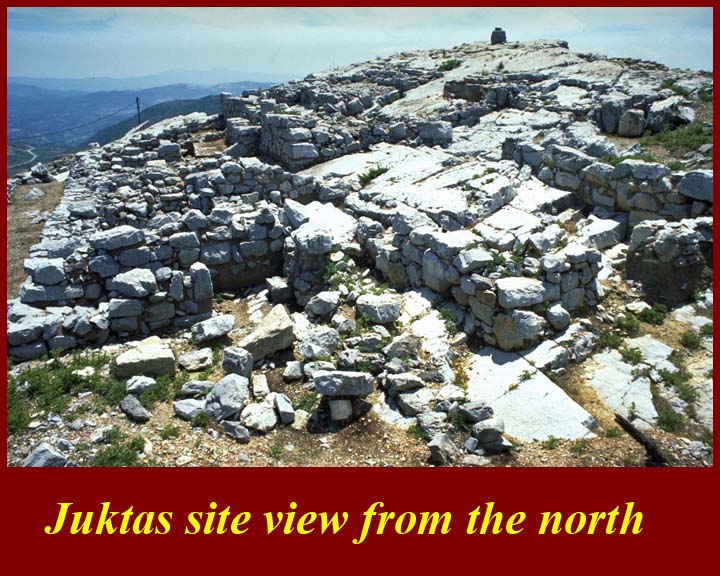
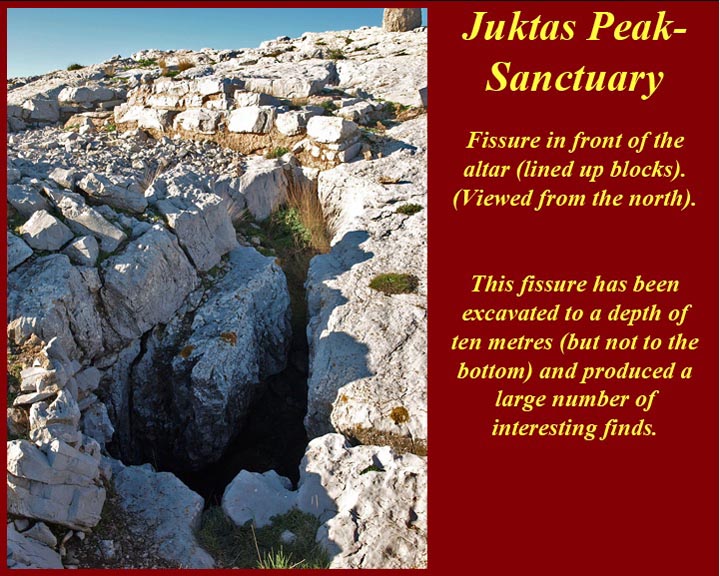
Mount Juktas is the site of one of the most important peak sanctuaries in the Minoan world, and probably the first of them. Archaeologists have studied the site over an extensive period, examining fragments of pottery, remains of walls, and some unique kinds of stone that must have been hauled up the mountain because they do not otherwise occur there.
Juktas was first excavated in 1909 by Sir Arthur Evans. It can be regarded as an adjunct archaeological site to the important Knossos site a few kilometres distant. Among the finds at the Juktas Minoan peak sanctuary were clay human and animal figurines, stone horns, stone altars, bronze double axes, and both bowls and tables with Linear A inscriptions. See references for a more comprehensive inventory. Pottery sherds from the site date back as far as Middle Minoan IA.
See http://www.minoancrete.com/juktas.htm.
Funerary customs
From https://answers.yahoo.com/question/index?qid=20110314044657AAJ8kyJ
There were many types of Minoan burial on Crete, with Cave burials, Chamber tomb or tholos tombs all being popular in different parts of the island and at different times.
See the above link for more a precis on Minoan Funerary Customs.
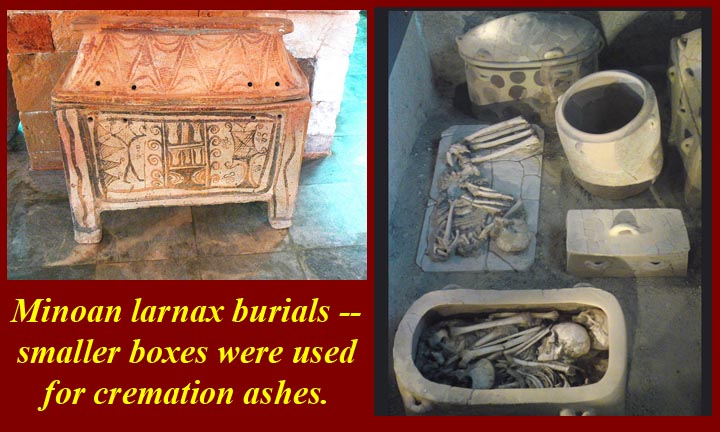
Larnake (singular is larnax) were boxes, usually made of wood of fired clay that would hold a body flexed as shown in the imabe. Sometimes more than one set of remains were found in a larnax.
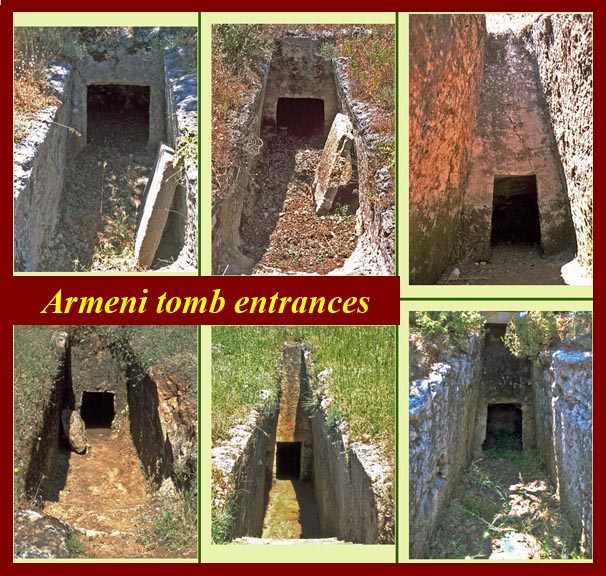
Entrances to Cretan chamber tombs and the interior of a tomb chamber.
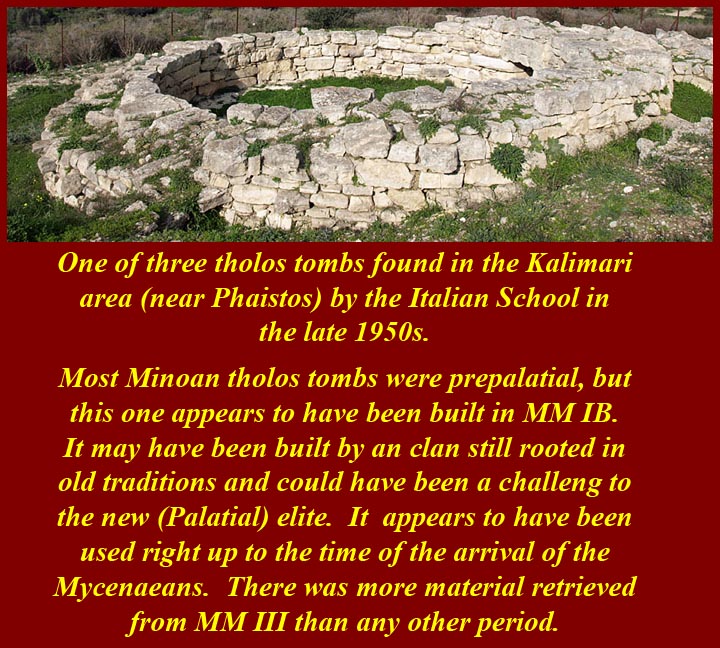
Remains of one of three tholos tombs near Kalimari and, for reference, a view of a complete tholos in Greece.
Minoans' End
Everything came crashing down on the Minoans one day around 1600 BC when the Minoan colony on Thera was vaporized along with most of the Island by a huge volcanic eruption -- about 70 cubic kilometers of dense rock equivalent (DRE in volcanology jargon) was blown high in the air in an Plinian eruption that was seventeen times the size of the 79 AD Vesuvius eruption (but less than one-seventeenth the size of the last Yellowstone super-eruption). On Crete, 90 miles south of Thera, there were earthquakes and some ash fall, but, because the winds were blowing east to west, not enough ash landed on Crete to wipe out the civilization. Nor were the earthquakes, serious though they were, enough to take down the population to unrecoverable size.
Ash fall from the Thera eruption as determined by core sampling -- red dots.
But, when the Thera Caldera collapsed, it sent three tidal waves, the first of which rose minimally thirty meters and maximally 150 meters as it climbed inland in Crete. (The 2004 Boxing Day Indian Ocean Tsunami was maximally the same as the minimal size ot the first Thera Tsunami.) The Thera caldera collapse sent at least two additional slightly smaller waves about forty-five minutes apart. (Attempts have also been made to tie the Tsunamis to the parting of the Red Sea by Moses.)
Computer model of tsunamis expected to have been generated by the Thera caldera collapse.
The Cretans, being a maritime people had concentrated their towns an population along the sea coast and mostly on the north coast facing their best customers. Like the folks who lived on the Aceh, Indonesia< coast in 2004, they didn't have a chance. There are only guesstimates on percentages of dead and devastated, but the losses in people (and protective navy ships) were serious enough to make Crete an easy target for the Mycenaeans. Some uplan outosts hung on for a while, but within a generation or two, Minoan civilization (and the Minoan archeological culture -- remember the definition with the second image at the top of this long page) were replaced by the Mycenaeans.
Significantly, the spoken Minoan language appears to have held on much longe than anything else. Hundreds of years later Greeks spoke of a language still in use by "eteocretans", i.e., "true Cretans". Homer mentions them in the Odyssey. Herodotus doesn't use the word eteocretans but refers to "the men of Praisos". Grafffiti on three pottery sherds found in Azoria, about thirty miles from Praisos in eastern Crete, a town abandonned in the early 5th century BC have been interpreted with some degree of certainty as being in the eteocretan language -- but written in forms of the Greek alphabet current in the sixth and fourth centuries BC respectively.

